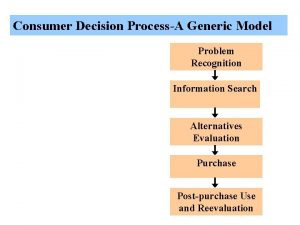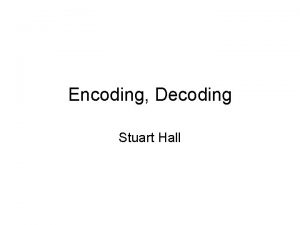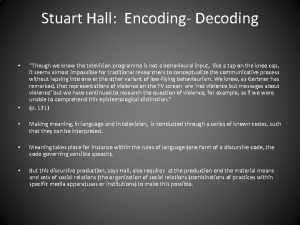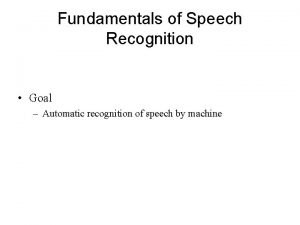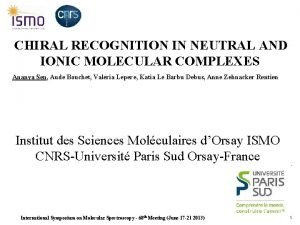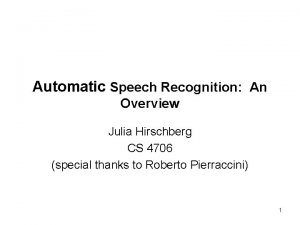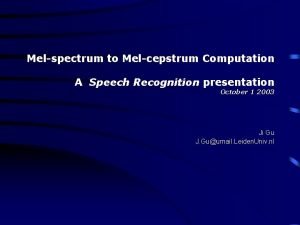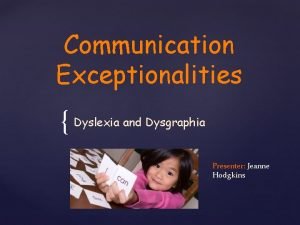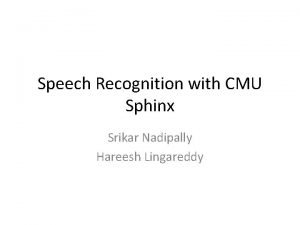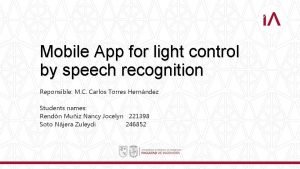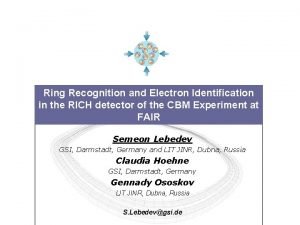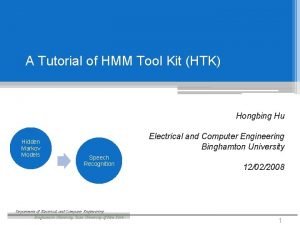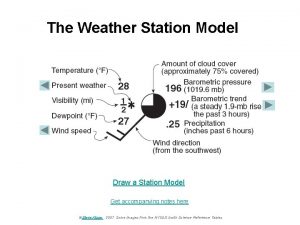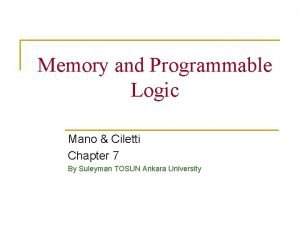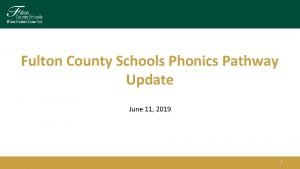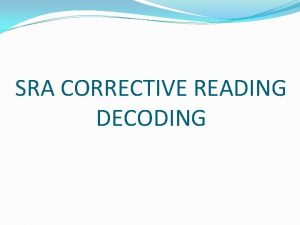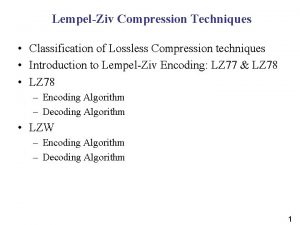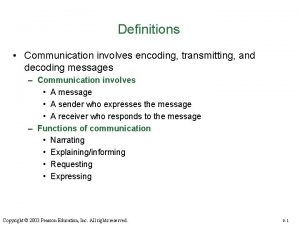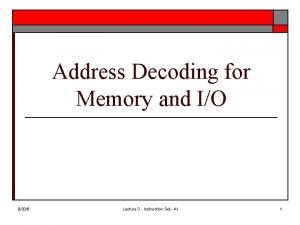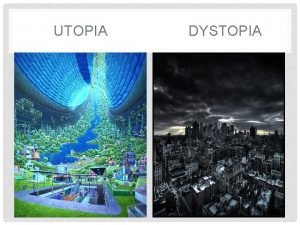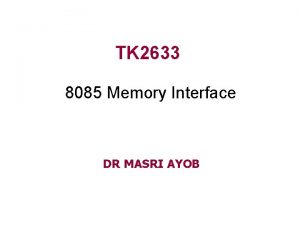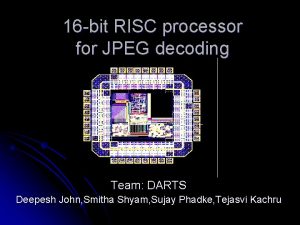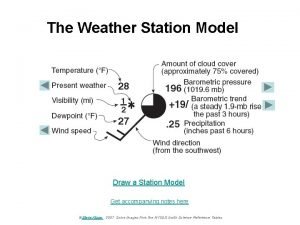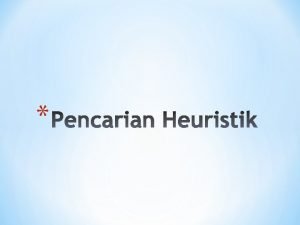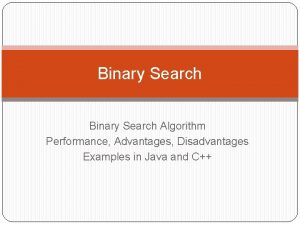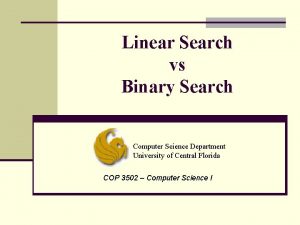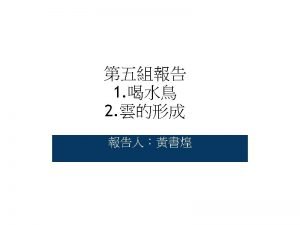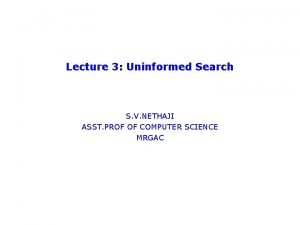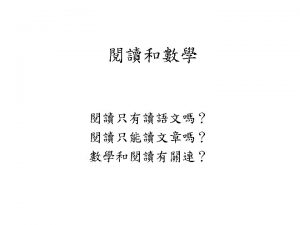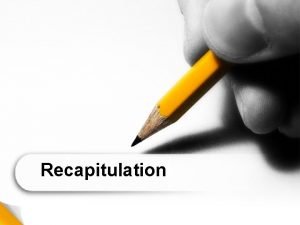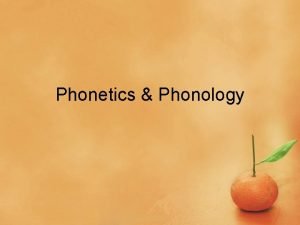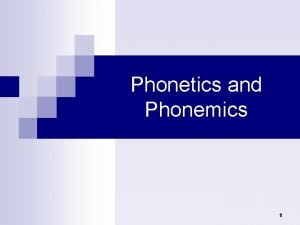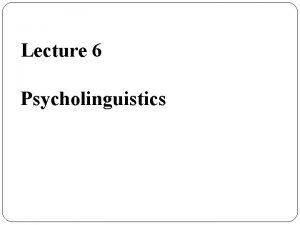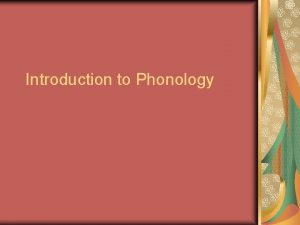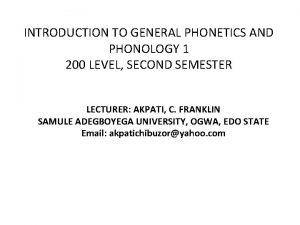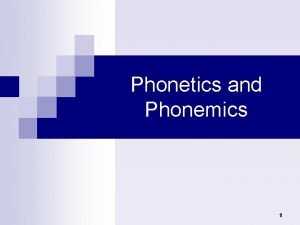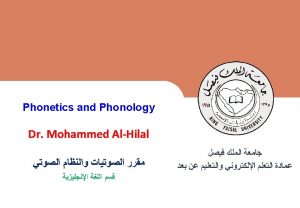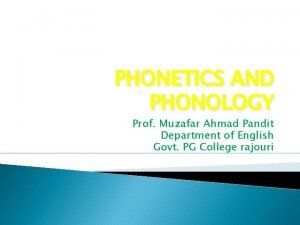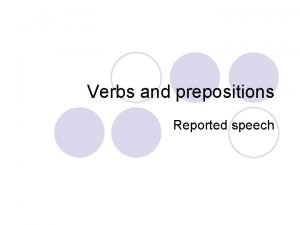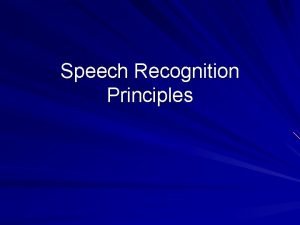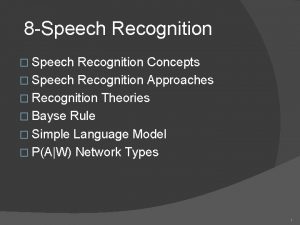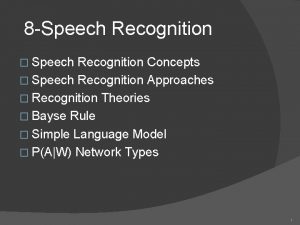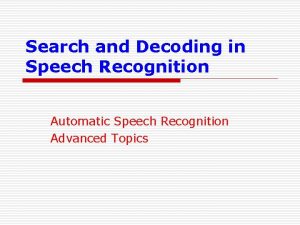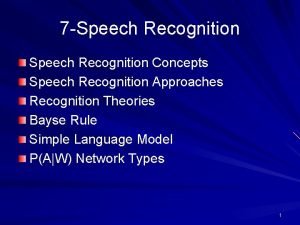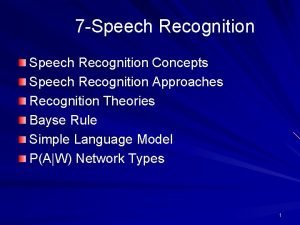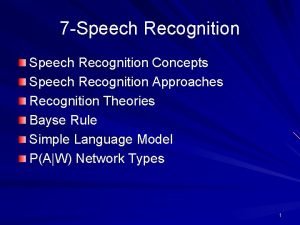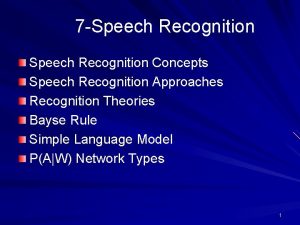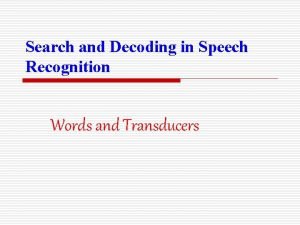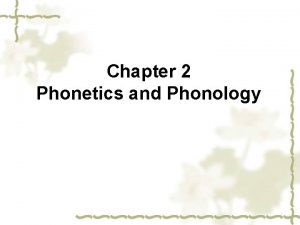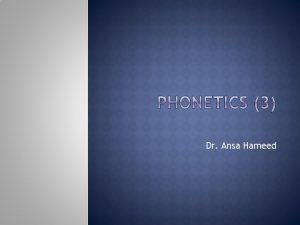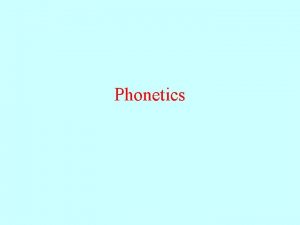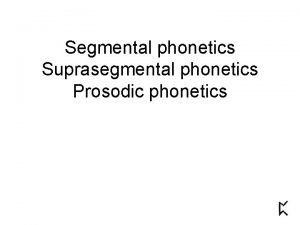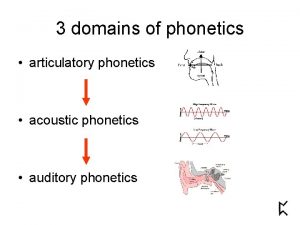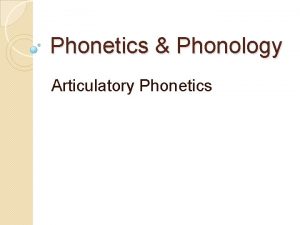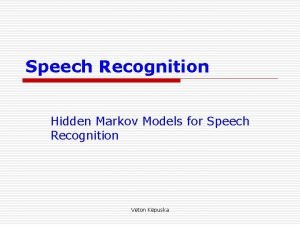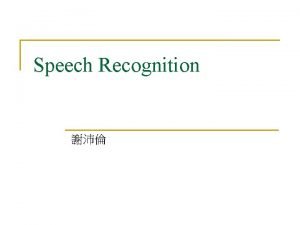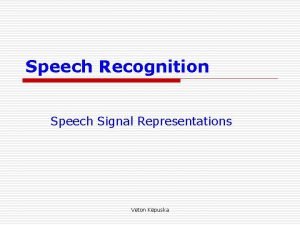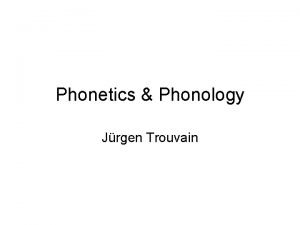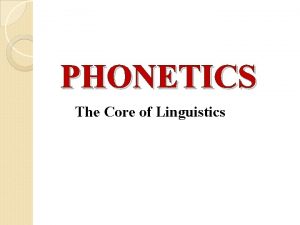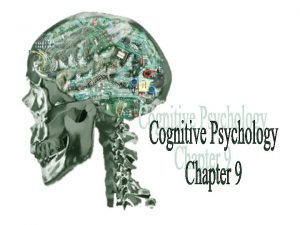Search and Decoding in Speech Recognition Phonetics Phonetics



















![Phone Variability u The same variation occurs for [k]; the [k] of sky is Phone Variability u The same variation occurs for [k]; the [k] of sky is](https://slidetodoc.com/presentation_image_h/c13f1818de59f88cde91795267e03d37/image-20.jpg)

![Phone Variability u There are other contextual variants of [t]. For example, when [t] Phone Variability u There are other contextual variants of [t]. For example, when [t]](https://slidetodoc.com/presentation_image_h/c13f1818de59f88cde91795267e03d37/image-22.jpg)

![Phone Variability u Another variant of [t] occurs before the dental consonant [th]. n Phone Variability u Another variant of [t] occurs before the dental consonant [th]. n](https://slidetodoc.com/presentation_image_h/c13f1818de59f88cde91795267e03d37/image-24.jpg)



![Assimilation u Examples: n /s/ becomes [sh], n /z/ becomes [zh], n /t/ becomes Assimilation u Examples: n /s/ becomes [sh], n /z/ becomes [zh], n /t/ becomes](https://slidetodoc.com/presentation_image_h/c13f1818de59f88cde91795267e03d37/image-28.jpg)





















![Vowels [ih] [ae] & [uh] 11/29/2020 Veton Këpuska 50 Vowels [ih] [ae] & [uh] 11/29/2020 Veton Këpuska 50](https://slidetodoc.com/presentation_image_h/c13f1818de59f88cde91795267e03d37/image-50.jpg)
















- Slides: 66

Search and Decoding in Speech Recognition Phonetics

Phonetics u Whole Word (logo-graphic) Written Systems: n “The earliest independently-invented writing systems (Sumerian, Chinese, Mayan) were mainly logographic: one symbol represented a whole word. u Systems Representing Sounds: n But from the earliest stages we can find, most such systems contain elements of syllabic or phonemic writing systems, in which symbols are used to represent the sounds that make up the words. n Thus the Sumerian symbol pronounced ba, meaning “ration”, could also function purely as the sound /ba/. n Even modern Chinese, which remains primarily logographic, uses sound-based characters to spell out foreign words. 11/29/2020 Veton Këpuska 2

Sound Based Systems u Purely sound-based writing systems: n Syllabic (like Japanese hiragana or katakana), n Alphabetic (like the Roman alphabet used in this book), or n Consonantal (like Semitic writing systems), can generally be traced back to these early logo-syllabic systems, often as two cultures came together. u Thus the Arabic, Aramaic, Hebrew, Greek, and Roman systems all derive from a West Semitic script that is presumed to have been modified by Western Semitic mercenaries from a cursive form of Egyptian hieroglyphs (? ) u The Japanese syllabaries were modified from a cursive form of a set of Chinese characters which were used to represent sounds. These Chinese characters themselves were used in Chinese to phonetically represent the Sanskrit in the Buddhist scriptures that were brought to China in the Tang dynasty. 11/29/2020 Veton Këpuska 3

Sound Based Systems u Modern theories of Phonology are based in theory of sound-based system in which the word is composed of smaller units of speech. u Modern algorithms for n Speech recognition (transcribing acoustic waveforms into strings of text words) n Speech synthesis or text-to-speech (converting strings of text words into acoustic waveforms) are based on the idea of decomposition of speech and words into smaller units 11/29/2020 Veton Këpuska 4

Phonetics u Phonetics is the study of n n linguistic sounds, how they are produced by the articulators of the human vocal tract, how they are realized acoustically, and how this acoustic realization can be digitized and processed. u Computational perspective of phonetics is introduced in this chapter. u Words are pronounced using individual speech units called phones. A speech recognition system needs to have a pronunciation for every word it can recognize, A text-to-speech system needs to have a pronunciation of every word it can say. u u 11/29/2020 Veton Këpuska 5

Phonetics u Phonetic Alphabets describe pronunciations u Articulatory phonetics – the study of how speech sounds are produced by articulators in human vocaltrack u Acoustic phonetics – the study of acoustic analysis of speech sounds. u Phonology – the area of linguistics that describes the systematic way that sounds are realized in different environment and how this system of sounds is related to the rest of the grammar. u Speech Variability – a crucial fact in modeling speech due to the fact that phones are pronounced differently in different contexts. 11/29/2020 Veton Këpuska 6

Speech Sounds and Phonetic Transcription IPA & ARPAbet Veton Këpuska

Speech Sounds and Phonetic Transcription u Pronunciation of a word is modeled as a string of symbols which represent phones or segments. n A phone is realization of a speech sound n Phones are represented with phonetic symbols that resemble letters in an alphabetic language like English. u Survey of the different phones of English, particularly American English showing how they are produced and how they are represented symbolically. 11/29/2020 Veton Këpuska 8

Speech Sounds and Phonetic Transcription u Two different alphabets are used in describing phones: u The International Phonetic Alphabet (IPA) – an evolving standard originally developed by the International Phonetic Association in 1888, with the goal of transcribing the sounds of all human languages. n The IPA in addition to being an alphabet it is also a set of principles for transcription. n Same utterance can be transcribed in different ways according to the principles of IPA. u The ARPAbet - another phonetic alphabet specifically designed for American English and which uses ASCII symbols. It can be thought of as a convenient ASCII representation of an American-English subset of the IPA. n ARPAbet is often used where non-ASCII fonts are inconvenient such as on-line pronunciation dictionaries. 11/29/2020 Veton Këpuska 9

ARPAbet and IPA for American. English 11/29/2020 Veton Këpuska 10

Phonological Categories & Pronunciation Variation Veton Këpuska

Phonological Categories and Pronunciation Variation u Realization/pronunciation of each phone varies due to a number of factors: n Coarticulation n Speaking style n Physical and emotional state n Environment n Noise Level etc. , … u In the next table a sample of the wide variation in pronunciation in the words because and about from the hand transcribed Switchboard corpus of American English telephone conversations is depicted. 11/29/2020 Veton Këpuska 12

Phone Variations 11/29/2020 Veton Këpuska 13

Phone Variability u How to model and predict this extensive variation? u Assumption is that mentally in each speaker there abstract categories that represent sounds: n n Tunafish [t uw n ah f ih sh] Starfish [s t aa r f ih sh] u The [t] of tunafish is aspirated. Aspiration is a period of voicelessness after a stop closure and before the onset of voicing of the following vowel. Since the vocal cords are not vibrating, , aspiration sounds like a puff of air after the [t] and before the vowel. By contrast, a [t] following an initial [s] is unaspirated; thus the [t] in starfish has no period of voicelessness after the [t] closure. This variation in the realization of [t] is predictable: whenever a [t] begins a word or unreduced syllable in English, it is aspirated. 11/29/2020 Veton Këpuska 14

Tunafish (aspirated) 11/29/2020 Veton Këpuska 15

Starfish (unaspirated) 11/29/2020 Veton Këpuska 16

Tunafish vs Starfish 11/29/2020 Veton Këpuska 17

Spectrograms of the Cardinal Vowels 11/29/2020 Veton Këpuska 18

Beet-Bat-Bott-Boot Beet /b iy t/ 11/29/2020 Bat /b ae t/ Veton Këpuska Bott /b a t/ Boot /b u t/ 19
![Phone Variability u The same variation occurs for k the k of sky is Phone Variability u The same variation occurs for [k]; the [k] of sky is](https://slidetodoc.com/presentation_image_h/c13f1818de59f88cde91795267e03d37/image-20.jpg)
Phone Variability u The same variation occurs for [k]; the [k] of sky is often miss-heard as [g] in Jimi Hendrix’s lyrics because [k] and [g] are both unaspirated. n ’Scuse me, while I kiss the sky - Jimi Hendrix, Purple Haze 11/29/2020 Veton Këpuska 20

Jimi Hendrix 11/29/2020 Veton Këpuska 21
![Phone Variability u There are other contextual variants of t For example when t Phone Variability u There are other contextual variants of [t]. For example, when [t]](https://slidetodoc.com/presentation_image_h/c13f1818de59f88cde91795267e03d37/image-22.jpg)
Phone Variability u There are other contextual variants of [t]. For example, when [t] occurs between two vowels, particularly when the first is stressed, it is often pronounced as a tap. u Recall that a tap is a voiced sound in which the top of the tongue is curled up and back and struck quickly against the alveolar ridge. n Thus the word buttercup is usually pronounced [b ah dx axr k uh p] rather than [b ah t axr k uh p]. 11/29/2020 Veton Këpuska 22

Buttercup 11/29/2020 Veton Këpuska 23
![Phone Variability u Another variant of t occurs before the dental consonant th n Phone Variability u Another variant of [t] occurs before the dental consonant [th]. n](https://slidetodoc.com/presentation_image_h/c13f1818de59f88cde91795267e03d37/image-24.jpg)
Phone Variability u Another variant of [t] occurs before the dental consonant [th]. n Here the [t] becomes dentalized. That is, instead of the tongue forming a closure against the alveolar ridge, the tongue touches the back of the teeth. 11/29/2020 Veton Këpuska 24

Abstract Classes u In both linguistics and speech processing we use abstract classes to capture the similarity among all these [t]s. u Phoneme – is the simplest abstract class u Allophones – are phonemes different contextual realizations. u In the next table a number of allophones of /t/ are summarized. 11/29/2020 Veton Këpuska 25

Allophonic Representations of /t/ 11/29/2020 Veton Këpuska 26

Phone Variability u Variation is even more common than the table presented previously for /t/ suggests. u Reduction or hypoarticulation. n One factor influencing variation is that the more natural and colloquial speech becomes, and the faster the speaker talks, the more the sounds are shortened, reduced and generally run together. u Assimilation n Assimilation is the change in a segment to make it more like a neighboring segment. The dentalization of [t ] to ([t”]) before the dental consonant [T] is an example of assimilation. n Palatalization is a common type of assimilation that occurs cross-linguistically. It occurs when the constriction for a sound segment moves closer to the palate than it normally would because the following segment is palatal or alveolo-palatal. 11/29/2020 Veton Këpuska 27
![Assimilation u Examples n s becomes sh n z becomes zh n t becomes Assimilation u Examples: n /s/ becomes [sh], n /z/ becomes [zh], n /t/ becomes](https://slidetodoc.com/presentation_image_h/c13f1818de59f88cde91795267e03d37/image-28.jpg)
Assimilation u Examples: n /s/ becomes [sh], n /z/ becomes [zh], n /t/ becomes [ch] and n /d/ becomes [jh], u We saw one case of palatalization in table of the slide Phone Variations in the pronunciation of because as [b iy k ah zh], because the following word was you’ve. The lemma you (you, your, you’ve, and you’d) is extremely likely to cause palatalization. 11/29/2020 Veton Këpuska 28

Phone Variability u Deletion is quite common in English speech – as in words about and it. u Deletion of final /t/ and /d/ has been extensively studied. n /d/ is more likely to be deleted than /t/, and both are more likely to be deleted before a consonant (Labov, 1972). n Next table shows examples of palatalization and final t/d deletion from the Switchboard corpus. 11/29/2020 Veton Këpuska 29

Palatalization and Final t/d Deletion 11/29/2020 Veton Këpuska 30

Phonetic Features Veton Këpuska

Perceptual Properties u Pitch and Loudness are related to frequency and intensity. n The pitch of a sound is the mental sensation or perceptual correlate of fundamental frequency. u In general if a sound has a higher fundamental frequency we perceive it as having a higher pitch. u This relationship is not linear, since human hearing has different acuities (keenness of perception : sharpness) for different frequencies. u Human pitch perception is most accurate between 100 Hz-1000 Hz, and in this range pitch correlates linearly with frequency. u Human hearing represents frequencies above 1000 Hz less accurately and above this range pitch correlates logarithmically with frequency. 11/29/2020 Veton Këpuska 32

CRITICAL BAND and CRITICAL BANDWIDTH u http: //www. sfu. ca/sonic-studio/handbook/Critical_Band. html: n n u For a given FREQUENCY, the critical band is the smallest BAND of frequencies around it which activate the same part of the BASILAR MEMBRANE. Whereas the DIFFERENTIAL THRESHOLD is the just noticeable difference (jnd) of a single frequency, the critical bandwidth represents the ear's resolving power for simultaneous tones or partials. In a COMPLEX TONE, the critical bandwidth corresponds to the smallest frequency difference between two PARTIALs such that each can still be heard separately. It may also be measured by taking a SINE TONE barely MASKed by a band of WHITE NOISE around it; when the noise band is narrowed until the point where the sine tone becomes audible, its width at that point is the critical bandwidth. Thus, frequencies of a complex sound within a certain bandwidth of some nominal frequency cannot be individually identified. When one of the components of this sound falls outside this bandwidth, it can be individually distinguished. We refer to this bandwidth as the critical bandwidth [A. R. Møller, Auditory Physiology, Academic Press, New York, USA, 1983]. A critical bandwidth is nominally 10% to 20% of the center frequency of the sound. 11/29/2020 Veton Këpuska 33

CRITICAL BAND and CRITICAL BANDWIDTH: Bark Scale u Bark: Mapping of acoustic frequency, f, to a “perceptual” frequency scale: n Units of this perceptual frequency scale are referred to as critical band rate, or Bark. 11/29/2020 Veton Këpuska 34

Bark Scale 11/29/2020 Veton Këpuska 35

Mel Frequency u Mel: A more popular approximation to this type of mapping in speech recognition is known as the mel scale. n The mel scale attempts to map the perceived frequency of a tone, or pitch, onto a linear scale. 11/29/2020 Veton Këpuska 36

Mel Frequency 11/29/2020 Veton Këpuska 37

Critical Bandwidth u An expression for critical bandwidth is: n This transformation can be used to compute bandwidths on a perceptual scale for filters at a given frequency on Bark or mel scales. 11/29/2020 Veton Këpuska 38

Critical Bandwidth 11/29/2020 Veton Këpuska 39

Mel & Bark Scale of Auditory Hearing of Pitch 11/29/2020 Veton Këpuska 40

Beats f 1=100 Hz f 2=110 Hz Beat Period Beat Frequency: f 2 -f 1 = 115 -100 = 15 Hz 11/29/2020 Veton Këpuska 41

Interpreting Phones from a Waveform u Much can be learned from a visual inspection of a waveform. For example, vowels are pretty easy to spot. u Recall that vowels are voiced; another property of vowels is that they tend to be long, and are relatively loud (as we can see in the intensity plot in Fig. 7. 16 in the next slide). Length in time manifests itself directly on the x-axis, while loudness is related to (the square of) amplitude on the y-axis. u Voicing is realized by regular peaks in amplitude of the kind, each major peak corresponding to an opening of the vocal folds. u Fig. 7. 17 shows the waveform of the short phrase ‘she just had a baby’. We have labeled this waveform with word and phone labels. Notice that each of the six vowels in Fig. 7. 17, [iy], [ax], [ae], [ax], [ey], [iy], all have regular amplitude peaks indicating voicing. 11/29/2020 Veton Këpuska 42

Switchboard Corpus Data 11/29/2020 Veton Këpuska 43

Switchboard Corpus Data 11/29/2020 Veton Këpuska 44

Spectra and the Frequency Domain u Some broad phonetic features (such as energy, pitch, and the presence of voicing, stop closures, or fricatives) can be interpreted directly from the waveform. u Most computational applications such as speech recognition (as well as human auditory processing) are based on a different representation of the sound in terms of its component frequencies. The insight of Fourier analysis is that every complex wave can be represented as a sum of many sine waves of different frequencies. u Consider the waveform in Fig. 7. 19. This waveform was created (e. g. Praat or MATLAB) by summing two sine waveforms, one of frequency 10 Hz and one of frequency 100 Hz. 11/29/2020 Veton Këpuska 45

10 Hz + 100 Hz Signal 11/29/2020 Veton Këpuska 46

Amplitude Spectrum 11/29/2020 Veton Këpuska 47

TIMIT Corpora 11/29/2020 Veton Këpuska 48

Vowels from TIMIT Sentence 11/29/2020 Veton Këpuska 49
![Vowels ih ae uh 11292020 Veton Këpuska 50 Vowels [ih] [ae] & [uh] 11/29/2020 Veton Këpuska 50](https://slidetodoc.com/presentation_image_h/c13f1818de59f88cde91795267e03d37/image-50.jpg)
Vowels [ih] [ae] & [uh] 11/29/2020 Veton Këpuska 50

Frequency & Amplitude; Pitch & Laudness 11/29/2020 Veton Këpuska 51

Pitch Tracking u There are various publicly available pitch extraction toolkits; for example an augmented autocorrelation pitch tracker is provided with Praat (Boersma and Weenink, 2005). u Windows Exe: n http: //www. fon. hum. uva. nl/praat/download_win. html u Information and Theory: n http: //www. fon. hum. uva. nl/praat/ u Source Code: n http: //www. fon. hum. uva. nl/praat/download_sources. html 11/29/2020 Veton Këpuska 52

Phonetic Resources

Phonetic Resousrces u Pronunciation Dictionaries – Online Dictionaries for English Languge: n CELEX n CMUdict n PRONLEX u LDC has released pronunciation dictionaries for n Egyptian Arabic, n German, n Japanese, n Korean, n Mandarin, and n Spanish 11/29/2020 Veton Këpuska 54

CELEX Dictionary u The CELEX dictionary (Baayen et al. , 1995) is the most richly annotated of the dictionaries. u It includes all the words in the Oxford Advanced Learner’s Dictionary (1974) (41, 000 lemmata) and the Longman Dictionary of Contemporary English (1978) (53, 000 lemmata), in total it has pronunciations for 160, 595 wordforms. u Its (British rather than American) pronunciations are transcribed using an ASCII version of the IPA called SAM. In addition to basic phonetic information like n n n n phone strings, syllabification, and stress level for each syllable, each word is also annotated with morphological, part of speech, syntactic, and frequency information. 11/29/2020 Veton Këpuska 55

CELEX Dictionary u CELEX (as well as CMU and PRONLEX) represent three levels of stress: primary stress, secondary stress, and no stress. For example, some of the CELEX information for the word dictionary includes multiple pronunciations (’d. Ik-S@n-r. I and ’d. Ik-S@-n@-r. I, corresponding to ARPABET [d ih k sh ax n r ih] and [d ih k sh ax n ax r ih] respectively), together with the CVskelata for each one ([CVC][CV] and [CVC][CV][CV]), the frequency of the word, the fact that it is a noun, and its morphological structure (diction+ary). 11/29/2020 Veton Këpuska 56

CMU Pronouncing Dictionary u The free CMU Pronouncing Dictionary (CMU, 1993) has pronunciations for about 125, 000 word forms. It uses an 39 -phone ARPAbet-derived phoneme set. u Transcriptions are phonemic, and thus instead of marking any kind of surface reduction like flapping or reduced vowels, it marks each vowel with the number 0 (unstressed) 1 (stressed), or 2 (secondary stress). n Thus the word tiger is listed as [T AY 1 G ER 0] n The word table as [T EY 1 B AH 0 L], and n The word dictionary as [D IH 1 K SH AH 0 N EH 2 R IY 0]. u The dictionary is not syllabified, although the nucleus is implicitly marked by the (numbered) vowel. 11/29/2020 Veton Këpuska 57

PRONLEX Dictionary u The PRONLEX dictionary (LDC, 1995) was designed for speech recognition and contains pronunciations for 90, 694 wordforms. u It covers all the words used in many years of the Wall Street Journal, as well as the Switchboard Corpus. u PRONLEX has the advantage that it includes many proper names (20, 000, where CELEX only has about 1000). Names are important for practical applications, and they are both frequent and difficult; we return to a discussion of deriving name pronunciations in Ch. 8. 11/29/2020 Veton Këpuska 58

Phonetically Annotated Corpus u Phonetically Annotated Corpus contains collection of waveforms that are hand-labeled with the corresponding string of phones. n TIMIT corpus n Switchboard Transcription Project corpus. 11/29/2020 Veton Këpuska 59

TIMIT Corpus u The TIMIT corpus (NIST, 1990) was collected as a joint project between Texas Instruments (TI), MIT, and SRI. u It is a corpus of 6300 read sentences, where 10 sentences each from 630 speakers. The 6300 sentences were drawn from a set of 2342 predesigned sentences, some selected to have particular dialect shibboleths, others to maximize phonetic diphone coverage. u Each sentence in the corpus was phonetically handlabeled , the sequence of phones was automatically aligned with the sentence wavefile, and then the automatic phone boundaries were manually handcorrected (Seneff and Zue, 1988). The result is a timealigned transcription; a transcription in which each phone in the transcript is associated with a start and end time in the waveform; we showed a graphical example of a time-aligned transcription in previous slide. 11/29/2020 Veton Këpuska 60

TIMIT Corpus u The phoneset for TIMIT, and for the Switchboard Transcription Project corpus is a more detailed one than the minimal phonemic version of the ARPAbet. u In particular, these phonetic transcriptions make use of the various reduced and rare phones mentioned in Fig. 7. 1 and Fig. 7. 2; the flap [dx], glottal stop [q], reduced vowels [ax], [ix], [axr], voiced allophone of [h] ([hv]), and separate phones for stop closure ([dcl], [tcl], etc) and release ([d], [t], etc). 11/29/2020 Veton Këpuska 61

Switchboard Transcription Project Corpus u Where TIMIT is based on read speech, the more recent Switchboard Transcription Project corpus is based on the Switchboard corpus of conversational speech. u This phonetically-annotated portion consists of approximately 3. 5 hours of sentences extracted from various conversations (Greenberg et al. , 1996). u As with TIMIT, each annotated utterance contains a time-aligned transcription. The Switchboard transcripts are time-aligned at the syllable level rather than at the phone level; thus a transcript consists of a sequence of syllables with the start and end time of each syllables in the corresponding wavefile. 11/29/2020 Veton Këpuska 62

Phonetically Transcribed Corpora for other Languages u Phonetically transcribed corpora are also available for other languages; n the Kiel corpus of German is commonly used, as are various n Mandarin corpora transcribed by the Chinese Academy of Social Sciences (Li et al. , 2000). u In addition to resources like dictionaries and corpora, there are many useful phonetic software tools. Praat package, which includes spectrum and spectrogram analysis, pitch extraction and formant analysis, and an embedded scripting language for automation. It is available on Microsoft, Macintosh, and UNIX environments. 11/29/2020 Veton Këpuska 63

PRAAT Software Package u In addition to resources like dictionaries and corpora, there are many useful phonetic software tools. u One of the most versatile is the free Praat package (Boersma and Weenink, 2005), which includes spectrum and spectrogram analysis, pitch extraction and formant analysis, and an embedded scripting language for automation. It is available on Microsoft, Macintosh, and UNIX environments. 11/29/2020 Veton Këpuska 64

SUMMARY u u u We can represent the pronunciation of words in terms of units called phones. The standard system for representing phones is the International Phonetic Alphabet or IPA. The most common computational system for transcription of English is the ARPAbet, which conveniently uses ASCII symbols. Phones can be described by how they are produced articulatorily by the vocal organs; consonants are defined in terms of their place andmanner of articulation and voicing, vowels by their height, backness, and roundness. A phoneme is a generalization or abstraction over different phonetic realizations. Allophonic rules express how a phoneme is realized in a given context. Speech sounds can also be described acoustically. Sound waves can be described in terms of frequency, amplitude, or their perceptual correlates, pitch and loudness. The spectrum of a sound describes its different frequency components. While some phonetic properties are recognizable from the waveform, both humans and machines rely on spectral analysis for phone detection. 11/29/2020 Veton Këpuska 65

SUMMARY u A spectrogram is a plot of a spectrum over time. Vowels are described by characteristic harmonics called formants. u Pronunciation dictionaries are widely available, and used for both speech recognition and speech synthesis, including the CMU dictionary for English and CELEX dictionaries for English, German, and Dutch. Other dictionaries are available from the LDC. u Phonetically transcribed corpora are a useful resource for building computational models of phone variation and reduction in natural speech. 11/29/2020 Veton Këpuska 66
 Examples of phonemes
Examples of phonemes Generic model of consumer behaviour
Generic model of consumer behaviour Stuart hall encoding decoding citation
Stuart hall encoding decoding citation Encoding advertising
Encoding advertising Stuart hall encoding
Stuart hall encoding Kinect for windows speech recognition language pack
Kinect for windows speech recognition language pack Fundamentals of speech recognition
Fundamentals of speech recognition Deep learning speech recognition
Deep learning speech recognition Aude leperre
Aude leperre Julia speech recognition
Julia speech recognition Melspectrum
Melspectrum How a dyslexic person sees text
How a dyslexic person sees text Cmu speech recognition
Cmu speech recognition Speech recognition
Speech recognition Speech recognition app inventor
Speech recognition app inventor Dragon speech recognition
Dragon speech recognition Electron speech to text
Electron speech to text Htk speech recognition tutorial
Htk speech recognition tutorial Barometric trend station model
Barometric trend station model Pengkodean data
Pengkodean data Dramqq
Dramqq Phonics pathway
Phonics pathway Decoding a flowers message sat answers
Decoding a flowers message sat answers Corrective reading placement test
Corrective reading placement test Decoding stylistics
Decoding stylistics Lzw decoding example
Lzw decoding example Greedy huffman coding
Greedy huffman coding Encoding definition in communication
Encoding definition in communication Partial address decoding
Partial address decoding Decoding the flu case study answers
Decoding the flu case study answers Decoding
Decoding Address decoding in 8085
Address decoding in 8085 Decoding long words
Decoding long words 16 bit risc
16 bit risc Weather station models
Weather station models Decoding skills
Decoding skills Sender encoding message decoding receiver
Sender encoding message decoding receiver Informed search and uninformed search
Informed search and uninformed search Blind search algorithm example
Blind search algorithm example Federated search vs discovery
Federated search vs discovery èinterest
èinterest Federated search vs distributed search
Federated search vs distributed search Https://images.search.yahoo.com/search/images
Https://images.search.yahoo.com/search/images Best first search
Best first search Blind search adalah
Blind search adalah Gravity yahoo
Gravity yahoo Yahoo
Yahoo What are the disadvantages of binary search
What are the disadvantages of binary search Search by image
Search by image Http://tw
Http://tw Multilingual semantical markup
Multilingual semantical markup Which search strategy is called as blind search
Which search strategy is called as blind search Tw.search.yahoo.com
Tw.search.yahoo.com Difference between phonetics and phonology
Difference between phonetics and phonology Questions about phonetics
Questions about phonetics Phonetics and phonology
Phonetics and phonology Introducing phonology answer key
Introducing phonology answer key Definition of consonants
Definition of consonants Drc model of reading
Drc model of reading Phonetics vs phonology
Phonetics vs phonology Introduction to general phonetics and phonology
Introduction to general phonetics and phonology Phonemics and phonetics
Phonemics and phonetics What is the difference between phonetics and phonology
What is the difference between phonetics and phonology Elearning
Elearning Phonetics and phonology
Phonetics and phonology Recognition and regard for oneself and one's abilities: *
Recognition and regard for oneself and one's abilities: * Match these sentences in direct and reported speech
Match these sentences in direct and reported speech

